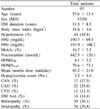1. Evans JL, Goldfine ID, Maddux BA, Grodsky GM. Oxidative stress and stress-activated signaling pathways: A unifying hypothesis of type 2 diabetes. Endocr Rev. 2002. 23:599–622.
2. Puddu P, Puddu GM, Galletti L, Ceavero E, Muscari A. Mitochondrial dysfunction as an initiating event in atherogenesis: A plusible hypothesis. Cardiology. 2005. 103:137–141.
3. Brownlee M. Banting lecture 2004. The pathobiology of diabetic complications: a unifying mechanism. Diabetes. 2005. 54:1615–1625.
4. Rohlfing CL, Wiedmeyer HS, Little RR, England JD, Tennill A, Godstein DE. Defining the relationship between plasma glucose and HbA1c. Diabetes Care. 2002. 25:275–278.
5. American Diabetes Association. Standards of medical care in diabetes. Diabetes Care. 2006. 29:suppl 1. S4–S42.
6. Hirsch IB, Brownlee M. Should minimal blood glucose variability become the gold standard of glycemic control? Journal of Diabetes and Its Complication. 2005. 19:178–181.
7. Monnier L, Colette C. Glycemic variability: Should we and can we prevent it? Diabetes Care. 2008. 31:suppl 2. S150–S154.
8. Monnier L, Mas E, Ginet C, Michel F, Villon L, Cristol JP, Colette C. Activation of oxidative stress by acute glucose fluctuations compared with sustained chronic hyperglycemia in patients with type 2 diabetes. JAMA. 2006. 295:1681–1687.
9. Service FJ, Molnar GD, Rosevear JW, Ackerman E, Gatewood LC, Taylor WF. Mean amplitude of glycemic excursions, a measure of diabetic instability. Diabetes. 1970. 19:644–655.
10. Boris P, Linda A, Erik O, William C. Evaluation of a new measure of blood glucose variability in diabetes. Diabetes Care. 2006. 29:2433–2439.
11. Boris P, Linda A, Daniel J, William C. Symmetrization of the blood glucose measurement scale and its applications. Diabetes Care. 1997. 20:1655–1658.
12. Levy JC, Matthews DR, Hermans MP. Correct homeostasis model assessment (HOMA) evaluation uses the computer program. Diabetes Care. 1998. 21:2191–2192.
13. Gottsater A, Ryden-Ahlgren A, Szelag B, Hedblad B, Persson J, Berglund G, Wroblewski M, Sundkvist G. Cardiovascular autonomic neuropathy associated with carotid atherosclerosis in type 2 diabetic patients. Diabet Med. 2003. 20:495–499.
14. Ziegler D, Laux G, Dannehl K, Spuler M, Muhlen H, Mayer P, Gries FA. Assessment of cardiovascular autonomic function: age-related normal ranges and reproducibility of spectral analysis, vector analysis, and standard tests of heart rate variation and blood pressure responses. Diabet Med. 1992. 9:166–175.
15. Boulton AJ, Vinik AI, Arezzo JC, Bril Vera, Feldman EL, Freeman Roy. Diabetic Neuropathies: A statement by the American Diabetes Association. Diabetes Care. 2005. 28:956–962.
16. Diabetes Control and Complication Trial Research Group. The relationship of a glycemic exposure (HbA1c) to the risk of development and progression of retinopathy in the diabetes control and complication trial. Diabetes. 1995. 44:968–983.
17. Klein R. Hyperglycemia and microvascular disease in diabetes. Diabetes Care. 1995. 18:258–268.
18. Brownlee M. Biochemistry and molecular cell biology of diabetic complication. Nature. 2001. 414:813–820.
19. UK Prospective Diabetes Study (UKPDS) Group. UKPDS) Group: Intensive blood glucose control with sulphonylureas or insulin compared with conventional treatment and risk of complication in patients with type 2 diabetes (UKPDS 33). Lancet. 1998. 352:837–853.
20. UK Prospective Diabetes Study (UKPDS) Group. UKPDS) Group: Effect of intensive blood glucose control with metformin on complication in overweight patients with type 2 diabetes(UKPDS 34). Lancet. 1998. 352:854–865.
21. Ohkubo Y, Kishikawa H, Araki E, Miyata T, Isami S, Motoyoshi S, Kojima Y, Furuyoshi N, Shichiri M. Intensive insulin therapy prevents the progression of diabetic microvascular complications in Japanese patients with NIDDM: a randomised prospective 6-year study. Diabetes Res Clin Pract. 1995. 28:103–117.
22. Thomas P, Frederick L. Postchallenge hyperglycemia in a national sample of U.S. adults with type 2 diabetes. Diabetes Care. 2001. 24:1734–1738.
23. Ceriello A. The post-prandial state and cardiovascular disease: relevance to diabetes mellitus. Diabetes Metab Res Rev. 2000. 16:125–132.
24. Heller SR. Minimizing hypoglycemia while maintaining glycemic control in diabetes. Diabetes. 2008. 57:3177–3183.
25. Cryer PE. The Barrier of hypoglycemia in diabetes. Diabetes. 2008. 57:3169–3176.
26. Ceriello A, Esposito K, Piconi L, Michael A, Jessica E. Oscillating glucose is more deleterious to endothelial function and oxidative stress than mean glucose in normal and type 2 diabetic patients. Diabetes. 2008. 57:1349–1354.
27. Schlichtkrull J, Munck O, Jersild M. The M-value, an index of blood-sugar control in diabetics. Acta Med Scand. 1965. 177:95–102.
28. Ryan EA, Shandro T, Green K, Paty BW, Senior PA, Bigam D, Shapiro AM, Vantyghem MC. Assessment of the severity of hypoglycemia and glycemic lability in type 1 diabetic subjects undergoing islet transplantation. Diabetes. 2004. 53:955–962.
29. George D. Assessing glycemic control with self-monitoring of blood glucose and Hemoglobin A1c measurements. Mayo Clin Proc. 2007. 82:229–236.
30. Bonora E, Formentini G, Calcaterra F, Bonadonna RC, Lombardi S, Muggeo M, Bonfante N. Plasma glucose levels throughout the day and HbA1c interrelationship in type 2 diabetes. Diabetes Care. 2001. 24:2023–2029.
31. Rachel D, Gerald A, Elizabeth G, Christopher D. Is HbA1c affected by glycemic instability? Diabetes Care. 2003. 26:2728–2733.
32. Vinik AI, Maser RE, Mitchell BD, Freeman R. Diabetic autonomic neuropathy. Diabetes Care. 2003. 26:1553–1579.







 PDF
PDF ePub
ePub Citation
Citation Print
Print




 XML Download
XML Download